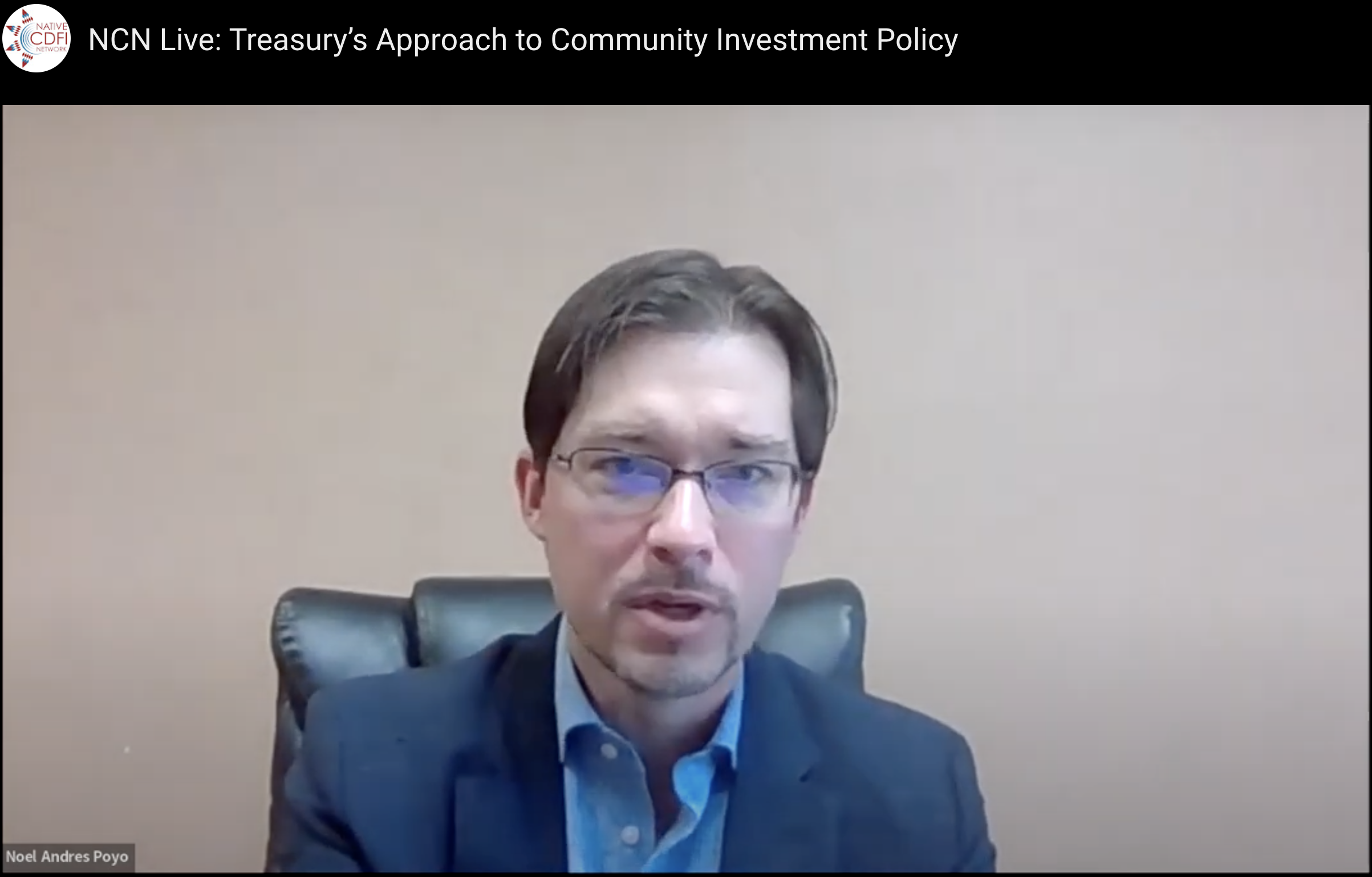
- Details
- By Elyse Wild
- Economic Development
Amid concerns over proposed changes to a key federal funding program used by Native Community Development Financial Institutions, a senior Treasury executive spoke with Native CDFI executives on a live streaming broadcast on Feb. 9.
The online broadcast — part of a new series from the Native CDFI Network called NCN Live — featured Noel Andrés Poyo, the Treasury’s Deputy Assistant Secretary for Community Economic Development (OCED). Poyo addressed the concerns about changes to the agency’s CDFI Fund certification application that have been widely shared by Native CDFIs in recent months.
The proposed changes Treasury is considering for the updated CDFI certification include the following:
- Requiring documentation of Native identity of CDFI clients
- Prohibiting interest-only mortgage loans, HELOCS, Construction LOCs, mortgage loans with balloon payments and mortgage loans with terms longer than 30 years.
- Limiting qualified developmental services
- Requiring board members to be executive staff of an organization that provides more than 50 percent of its service to low-income populations.
Per previous Tribal Business News reporting, the proposed changes, if enacted, could shut out many Native CDFIs from the fund altogether
Poyo acknowledged the distress Native CDFIs expressed about how proposed changes could alter the economic landscape of Indian County. He said the Treasury intends the process of finalizing the changes to be substantive, and expressed appreciation for NCN and its members “telling it like it is” about the proposed changes.
“I am so grateful to the Native CDFI Network telling it like it is, giving feedback, identifying places where there is need for clarification, more detail, and where we got it wrong,” Poyo said. He noted that the update to the CDFI certification has been in the works for six years. The CDFI certification application has not been updated since the fund was founded in 1994.
The live stream followed the publication of a survey of Native CDFI professionals, documenting the likely financial impact the proposed changes would have on Indian Country.
More than two-thirds of respondents said they were “gravely concerned” or “moderately concerned” about proposed mortgage restrictions, while 30% said the proposed changes would prevent their CDFI from achieving/retaining Treasury certification.
More than 93% of the Native CDFIs survey said they would either have to “substantially change” how they serve clients or that their application would likely be rejected under their current operating structure.
One respondent wrote: “Our Native CDFI will be forced to spend more time on ensuring our continued CDFI certification and less on providing CDFI services to Native Americans.”
In the absence of traditional banks, Native CDFIs have been critical to driving economic development and access to capital in Native American communities.
In 2001, the CDFI Fund published a study identifying significant barriers to investment in Indian Country. As a result, the fund launched Native Initiatives to support the creation and development of Native CDFIs. Today, 64 certified Native CDFIs operate throughout Indian Country, according to NCN.
Poyo is no stranger to the economic needs of vulnerable populations. He spent 14 years as Executive Director of the National Association for Latino Community Assets Builders and was CEO of Escalera Community Investments, before joining Treasury in 2021.
Along with overseeing the CDFI Fund, Poyo has been involved in managing several funds created to mitigate the impact of COVID-19. He played a role in administering the American Rescue Plan (ARP) rental assistance and homeowner fund programs, as well as the $9 billion Emergency Capital Investment Program that deployed capital to CDFIs and minority depository institutions.
During the live stream, Poyo spoke about the flood of capital that the Treasury has directed to CDFIs and vulnerable communities through new and updated programs including the CDFI Rapid Response and Equitable Recovery programs.
“Tens of billions of dollars have been flowing,” Poyo said. “And there has been really specific thinking about how those dollars (are lent to) communities and how to ensure that an equitable recovery leads to equitable actions.”
The growth in funding, demand and the number of CDFIs nationwide has necessitated clarification on what a CDFI is, Poyo said.
Today, there are 1,380 CDFIs throughout the United States, according to the CDFI Fund’s 2022 Financial Report — a 232% increase since 2000. The number of Native CDFIs have grown from 16 to 64 during the same period.
According to the 2022 report, demands for CDFI Fund awards exceed the supply of resources for nearly all of its programs. In 2022, more than 40% of Certified CDFIs applied for financial assistance or technical assistance funding — the largest number ever to apply to a single round of the CDFI Program and the Native American CDFI Assistance Program.
NCN Chairperson and Interim CEO Pete Upton, who hosted the podcast, pointed out that the number of non-Native CDFIS significantly exceeds the number of Native CDFIs — and therefore are not the organizations straining the fund.
When Upton asked Poyo if that was being considered, Poyo responded, “The primary concern here isn’t bad actors; it’s about getting it right.”
Poyo said that, while not the driving issue, providing more specific premiers for certification offers clarity to investors looking to get into the CDFI space.
While few participants spoke during the live stream, those who did emphasized that the role of Native CDFIs extends beyond deploying money into Native communities and into developing much-needed financial literacy, especially in small business owners, homeowners and Native youth.
According to the proposed changes to the certification, CDFIs would be barred from counting youth-based programs as qualifying development services and would be limited in the amount of staff time dedicated to development services.
Poyo said that development services need to have a connection to a potential borrower.
“The issue here is whether the fund is staying within its statute and its regulation,” Poyo said.
While Poyo could not provide clarity on when the new rules would roll out or how quickly CDFIs who aren’t in compliance would be de-certified, he reiterated that the Treasury is listening and acting deliberately.
“I’m really interested in knowing more and better how we solve the challenge of having more of these essential financial intermediaries delivering capital in native communities,” Poyo said.
Upton, advocating for Native CDFIs, referred to the origins of organizations and how its ongoing needs are specific to Indian Country.
“When Native CDFIs were created, there was a separate set of rules created that allowed them to get into the game, so to speak,” Upton said. “We were created as a subset, and as the CDFI fund has developed, we’ve been thrown into the bucket with everyone else.”
Upton concluded the live stream by underscoring how essential program and lending flexibility are to Native CDFIs.
“My only parting comments are that Native CDFIs are sometimes the only resource in Native communities, which are the most underdeveloped of all races. So please keep that in mind. We have to have a lot of flexibility.”
